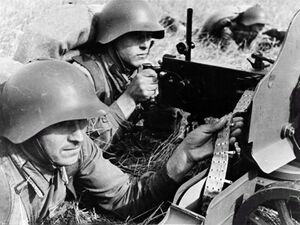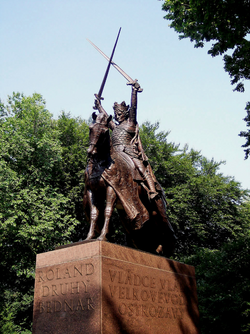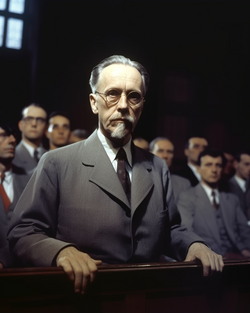User:Moldyvan/Sandbox4
History
Early history
Settlement of the territory of modern Ostrozava began in the Paleolithic era; sites in northeastern Ostrozava form a continuum with <CIVILIZATION> sites found in Ludvosiya, Velikoslavia, and Zamorodna, which showcase a gradual increase in complexity, including the earliest known evidence of salt mining in Belisaria. The during the Bronze Age the earliest peoples inhabiting Ostrozava included the Valenii, Talencii, and several waves of migratory Proto-Magnic tribes. The latter later began to urbanize around the confluence of the Karmin and Balarog Rivers, leading to the establishment of the Gothic confederation of Tervingia around 323 BCE. Tervingia developed a strong economy, becoming proficient in agriculture, crop-rotation, and metalworking, eventually controlling large swathes of central and eastern Belisaria at its largest extent in 220 CE. Tervingia's borders, largely based on tribute and patronage networks, fluctuated largely, and areas such as Valdavia were often simultaneously subject to demands of tribute and waves of settlement from both the Latin and Tervingian Empires, with the former taking direct control of southern Tervingia in 292 CE for a period of 100 years. Successive migrations of Ludic peoples continued to drastically impact the societal makeup of Tervingia, led to the introduction of syncretic forms of Nazarism which replaced the earlier Cult of Tyr, and slowly eroded the centralized power of the empire, which culminated in the Sack of Saragetra and subsequent collapse of Tervingia in 428 CE.
After Tervingia's collapse, several new polities emerged, chief among them the Gotho-Ludzic Kingdom of Karsko in the north and the Eastern Latinic Kingdom of Valdavia in the south. Spurred by the increasing arrival of displaced missionaries and adherents from western Belisaria, the earlier Nazarist syncretism in Transkarminia began to give way to codified feudal systems anchored in Alban Nazarism. While the collapse had reduced the former Tervingian capital of Saragetra to a mere village by the late 8th century, settlements such as Karsko, Balta, Levigora, and Helbarstätt continued to grow, with several migratory waves continuing to impact the ethnic makeup of the region, leading to the displacement of Gothic remnants to the future Ludvosiya, the Azdraï or their assimilation by the local populace.
Medieval Period
By the mid-9th century, the Kingdom of Karsko's expansion into northern territories including Vamo, Ardovia, and Baderia had quickened owing to its economic growth from the amber trade making it a hub for mercenaries, mainly composed of Gothic and Ludic tribesmen. One such confederation of tribesmen, arriving from the north from what is now Drevstran, invaded and took control of Karsko from the ruling Bednar family in 962. Their leader, Roland Válek, a military commander who claimed descent from Queen Lorelei of Tervingia, consolidated power by becoming the first Voivodar of Ostrozava and establishing the Válek dynasty in 967 CE. Subsequently, the Dukes of Ardovia and Vamo swore fealty to the nascent Ostrozava, emboldening political willpower for further territorial growth. In the south, Valdavian dukes attempted an expansion into Rheigen and the Gariman plain in 1001 but was repulsed by forces of the nascent Holy Audonian Empire, which began to pay increasing attention to the Alban polities around Lake Kupalnitsa, which they considered heretical; this culminated in the failed Valdavian Crusade in 1197, which nevertheless greatly weakened Valdavia. By 1240, after having failed to entrench a series of political marriages with Valdavian rulers under Otmar I "The Builder", Ostrozava instead invaded Valdavia under his successors Zikmund I and Roland II "The Great", pre-empting a potential second crusade while Fabrian and Holy Audonian attention had been on the Lushyods to the east, taking not only Valdavia but also the Audonian provinces of Rheigen and Polnitsa in the Ostrozavan Wars of Expansion.
By 1300, the Ostrozavan Voivodarate had begun to portray itself as the primary defender of the Alban faith, bringing with them an ethnically and religiously diverse populace; revolt was common, and a series of Fabrian uprisings would halt further expansion southwards by 1310, coupled with the increasing threat of a second wave of crusades. Embittered by the potential of increasing retaliatory aggression from the Fabrians, Roland II began the Emendatic Wars when he invaded the Lushyodorstag in 1318, hoping to reclaim the Alban Pentapolis and further consolidate Alban control over the southern Kupalnitsa. However, the invasion was a failure, and led to the death of the Ostrozavan heir, Gabriel, at the Second Battle of Barbellon. The subsequent political turmoil after Prince Gabriel's death and the loss of the Pentapolis would put a permanent stop to Ostrozavan expansionism and embitter the nobility. Between 1329 and 1335, Kamil Válek, Count of Karschberg and third-in-line to the throne, challenged the new High Voivodar Viktor's claim, leading to the First War of Ostrozavan Succession, which would end in a victory and consolidation of power for Viktor, and the adoption of a defensive posture, resulting in developmental improvements in infrastructural, judicial, and diplomatic norms. While some of the new Ostrozavan acquisitions, such as Rheigen, continued to be marred by religious turmoil, the increasing interconnectedness of Ostrozavan and Valdavian land proved beneficial for development; it became customary for a Voivodar of Ostrozava to marry a Valdavian princess, further entrenching the political capital of the Válek dynasty regionally. Urban life began to develop in earnest after <DEPOPULATION EVENT>, with a class of multi-ethnic urban burghers organized into guilds emerging and providing an economic boon to the region. While many of these burghers were locals, they also began to count among their ranks Kupalnitsan Jews arriving from the Alban Pentapolis, Lushyods, Ludz of the Drev, Rheigners, and Schaumbergers. This cosmopolitan influx of trade led to the revitalization of the former Tervingian capital of Saragetra, now known as Valegoria, which was strategically located at an important confluence of Transkarminian trade, and of Levigora, whose port served as the closest link between the Ostrozavan lands and those of the Alban Pentapolis. Tensions with Fabrian minorities, both in Magnic Rheigen and Ludic Ardovia, however, continued to impede stability and generate tensions with the Fabrian world to the south and southwest, especially as more missionaries continued to arrive across the trade routes. In 1351, the northernmost regions of Ostrozava entered into crisis when the Duchy of Baderia, which had been operating under the suzerainty of the Ostrozavan crown, found itself pressured and eventually subsumed by the Great Kvor Host enlisted by the neighboring Principality of Kollavik. The Host would eventually expand their control to the hilly regions to the west of Baderia, previously contested between Ludic and Pojahaaman lords, but would otherwise refrain from attempting further expansion into Ostrozava given the difficulty of mounted warfare in the northern swamps of Vamo and Strakosko.
Eastern Renaissance
After Viktor II's brief reign and death from consumption in 1398, his young son Aurel I assumed the throne, under a regency council headed by Duke Zigmund Dobrovodsky of Litovia. The open economic climate of Ostrozava at the time had led to a gradual cooling of relations with the Lushyods, which had been further bolstered by expanded trade links routed through Levigora, a move seen as necessary in the face of the increasing attention being given to Fabrian minorities by the Holy Audonian Empire. At the 1405 Council of Pyrovegny, the Alban and Docetic Nazarists agreed to bridge their differences with the creation of an Oecumenical Bible equally valid to both doctrines, and written in the dominant Vestrozavan dialect of the Alban Pentapolis. The Docetic Academy's first missionaries arrived in Valdavia in 1407, garnering protest from remaining Fabrian nobles and even an attitude of tolerance from the Emendatic priesthood and political establishment. Ostrozava's increasing closeness with their former rivals in the face of anti-Nazarist forces was further cemented two years after the end of the Dobrovodsky regency in 1408, when Aurel I took Princess Anika of the Gerzaïd dynasty as his wife, eschewing the typical political marriage into Valdavian nobility. Aurel was the first Ostrozavan monarch to style himself as High Voivodar; banking on the title's symbolic power to further cement his soft power. The increasing political closeness of the two sides of the Lake, known as the Kupalnitsan Compact, coupled with the loosening of religious dogma to allow a new era of technological and cultural development to grow, known as the Eastern Renaissance. In Ostrozava, the Renaissance began in earnest with the University of Karsko's foundation in 1458, which brought codified education to Transkarminia and began to serve as a nexus of developments in science, philosophy, and Nazarist theology. Several polymaths began to flourish in the region, with one of the most famous being Boris Matușek, a painter and engineer who was appointed Master of the Arts by Aurel in 1461.
In 1443, Zoe II came to power in Mesogeia and began a campaign of religious persecution against all non-Apostolic Sarpetic faiths, branded as heretics, many of Alban and Aletheic refugees came to Ostrozava along the growing avenues of the Jade Road, bringing with them insights and technologies from the polities of the East and Far East, and contributing to the cultural and religious tolerance that had been established in the area. Some major technological advances brought to Ostrozava during this time included gunpowder, which had already been present as early as 1410, but began to be produced at the Deva Arsenal in 1449. Developments in architectural engineering and fashion led to the emergence of Ostrozavan renaissance architecture; Kadleți Castle in Orloșka, finished in 1452, is considered the first major example of the style in Eastern Belisaria. Gothic architecture also continued to grow in popularity after skilled Rheigner craftsmen brought the style in from the Holy Audonian Empire. The need to quickly distribute new Oecumenical Bibles following the influx of Alban refugees led to the importation of the movable-type printing press, with religious academies and Lauras serving as a hub of an infant bookmaking industry. Aurel I died in 1467, leaving the realm to Radovan I "The Hammer", who increased taxation along the Karmin in order to fund increasingly extravagant construction projects, particularly the Grand Laurate Temple in Karsko, and began to ease the attitude of religious tolerance that his father had established with regard to the Christian faiths. The Fabrian minorities of Ostrozava, centered around the former Audonian regions of Polnitsa and Rheigen, and brought to the mountains of Ardovia by travelling missionaries, had become increasingly irritated by these additional taxes; local violence became increasingly sporadic in areas that had yet to feel the effects of the Renaissance. A major revolt came in 1479, when Baudry Zÿler, a Rheigner burgher and Baron of Bischoffelden, refused to pay the Voivodar's increasingly-extravagant salt tax, which would only have. When troops were sent in from Valegoria to arrest Zÿler, they were defeated by an organized force of 700 men in war wagons, sparking Zÿler's Rebellion, which would last for two years after spreading through much of Fabrian Ostrozava. After his capture at the Battle of Zarda, Zÿler was executed in 1482 by being broken on the wheel, causing further unrest but also turning him into a martyr. Zÿler remains a national icon of Ostrozava today.
Declension and Velikoslav Suzerainty
Rising tensions with Fabrian minority lords, sufficiently exacerbated by Zÿler's Rebellion, came to a boiling point in 1494, when, after Radovan's General Infantry Decree prohibited Fabrians from serving as mercenaries and bodyguards, or holding weapons, many Fabrians were simultaneously robbed of their livelihoods and disarmed in the wake of what was assumed to be an impending wave of forced conversions. On New Years' Day, the Margrave of Helbarstätt, Bertolt Hengst, who had positioned himself as a beacon of Kupalnitsan tolerance and a protector of Fabrian Ostrozavans in the aftermath of the Rebellion, took up arms against the High Voivodar, meeting the main Ostrozavan army in battle outside of Valegoria. Through building on the Zÿlerites' use of war wagons and firearms, Ostrozavan forces were unexpectedly routed early into the battle. During the fighting, Radovan was separated from his lines and presumed drowned at the Great Fork. Following the Battle of the Great Fork, Hengst marched his forces north to Karsko, where they took the city bloodlessly. With the remaining Váleks in disarray, and having gained the favor of both the populace and the Pope, Hengst usurped power from the Alban establishment, ending centuries of Válek rule and ending Alban dominance over Transkarminia in less than two months in what came to be known as the Forty-Nine Days' War. However, Fabrian rule over Ostrozava was short-lived; the Nazarist majority became unruly at the loss of the status-quo, and Velikoslav victories in Baderia in 1488 had weakened the frontier of a Voivodarate already in disarray. After less than three decades of unstable rule, Hengst faced a major Velikoslav invasion in 1523, By 1528, Ostrozavan forces were thoroughly defeated, and Hengst, alongside members of his dynasty, were forced out of Karsko by hostile forces. Upon their arrival in Valegoria, they found that local lords were already coalescing around Victor Belododia, a Fabrian Valdavian lord and Lord Mayor of Valegoria married to Hengst's second daughter. By 1531, Victor had proclaimed the Kingdom of Valdavia-Rheigen in the south, terminating his father-in-law's claim and initiating the Ostrozavan Declension; following suit, lands not already subsumed under Velikoslav rule began operating independently of central authority, including the lords of Zarda, Ardovia, Polnitsa, and Levigora. Valdavo-Rheigner rule, though limited to the southwestern half of the former Ostrozava, would return the region to an attitude of religious pluralism, rebuilding alliances with the Lushyods and with XX in order to prevent further encroachment by the Velikoslavs. Several minor conflicts continued, with the Duchy of Polnitsa coming under Gariman control in 15XX. With Nazarist control no longer cemented in the region, and Fabrianism continuing to hold at-most tentative support with the lords of Valdavia-Rheigen, the region found itself under increasing influence from the ideas of the Protestant Reformation which had begun in Garima.
In the conquered lands of northern Ostrozava, Velikoslav shit happened.
Vykopal Era & Thirty Years War
Growing Unrest
Rioting and strikes of minor industries intensified over the next half-decade; in 1905 the Empire of Transkarminia formally abolished serfdom, being one of the last states in Belisaria to commit to the policy. The abolition of serfdom sent hundreds of former serfs flooding into the cities, creating a homelessness crisis amid the winter of 1905-06, which saw over 2,500 dead of hypothermia. The Black Winter of 1906, named for the frostbitten former serfs' blackened features, would see blame laid at the feet of the Vykopal dynasty.Utrătenia
Crimson Revolution & First Compact
Rytieriroz and Growing Regional Tensions
Containment War & Socialist Consolidation
Second Compact and Great Republican War

The Correction
Third Compact






